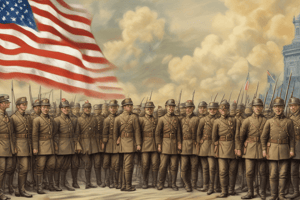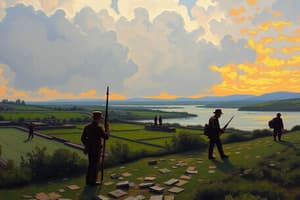Podcast
Questions and Answers
The assassination of Archduke Franz Ferdinand was part of which larger conflict that led to the outbreak of World War I?
The assassination of Archduke Franz Ferdinand was part of which larger conflict that led to the outbreak of World War I?
The conflict between the Austro-Hungarian Empire and Serbia.
How did the Bolshevik Revolution affect the war?
How did the Bolshevik Revolution affect the war?
- The Bolsheviks shifted Russian forces toward fighting the Ottoman Empire, drawing Ottoman troops away from the Western Front.
- The Bolsheviks switched sides in the war, becoming allied with Germany and the Central Powers.
- The Bolsheviks ended Russia's fighting in World War I, eliminating the fighting on the Eastern Front. (correct)
- The Bolsheviks renewed the Russian war effort against the Central Powers, drawing many German troops away from the Western Front.
What were some of the issues that impeded the implementation of President Wilson's ideal peace plan?
What were some of the issues that impeded the implementation of President Wilson's ideal peace plan?
Wilson's Fourteen Points were considered too idealistic, and he faced political opposition.
Identify some of the problems that the United States faced domestically following the end of World War I.
Identify some of the problems that the United States faced domestically following the end of World War I.
What was Clemenceau's concern regarding the state of the war in December 1917?
What was Clemenceau's concern regarding the state of the war in December 1917?
When the United States declared war on Germany, the U.S. Army was ____ for battle.
When the United States declared war on Germany, the U.S. Army was ____ for battle.
Identify some of the positions President Wilson held and ultimately conceded during and following the Paris Peace Conference.
Identify some of the positions President Wilson held and ultimately conceded during and following the Paris Peace Conference.
What were some characteristics of World War I that made it the first industrial war?
What were some characteristics of World War I that made it the first industrial war?
Identify some components of the Revenue Act of 1916.
Identify some components of the Revenue Act of 1916.
Describe the political battle in the U.S. over ratifying the Treaty of Versailles.
Describe the political battle in the U.S. over ratifying the Treaty of Versailles.
Put the following post-World War I events in chronological order.
Put the following post-World War I events in chronological order.
How did the Battle of Verdun indicate that World War I would be different from any previous war?
How did the Battle of Verdun indicate that World War I would be different from any previous war?
Identify the chronology of German actions that pushed the United States to join the war.
Identify the chronology of German actions that pushed the United States to join the war.
Identify the contributions of the Boy Scouts and Girl Scouts to the war effort.
Identify the contributions of the Boy Scouts and Girl Scouts to the war effort.
Complete the passage describing the ramifications of the assassination of Archduke Franz Ferdinand.
Complete the passage describing the ramifications of the assassination of Archduke Franz Ferdinand.
How did President Wilson respond to the request from civil rights leaders regarding racial discrimination?
How did President Wilson respond to the request from civil rights leaders regarding racial discrimination?
How was Wilson's Fourteen Points received by European nations at the Paris Peace Conference?
How was Wilson's Fourteen Points received by European nations at the Paris Peace Conference?
Identify how the ratification of the Nineteenth Amendment changed the political landscape of the U.S.
Identify how the ratification of the Nineteenth Amendment changed the political landscape of the U.S.
Identify how World War I shaped postwar events on the international stage.
Identify how World War I shaped postwar events on the international stage.
Put in chronological order the events contributing to the U.S. joining World War I.
Put in chronological order the events contributing to the U.S. joining World War I.
President Wilson's populist transcontinental speaking tour caused enough pressure for ratification of the Treaty of Versailles.
President Wilson's populist transcontinental speaking tour caused enough pressure for ratification of the Treaty of Versailles.
The majority of American troops who died during World War I died in combat.
The majority of American troops who died during World War I died in combat.
What unique aspects of World War I does the quotation from a British army chaplain address?
What unique aspects of World War I does the quotation from a British army chaplain address?
The German decision on January 31, 1917 to sink all non-German ships resulted in the U.S. joining World War I.
The German decision on January 31, 1917 to sink all non-German ships resulted in the U.S. joining World War I.
Identify criticisms of Wilson's League of Nations proposal.
Identify criticisms of Wilson's League of Nations proposal.
In what ways did the U.S. entry into World War I contribute to the defeat of the Central Powers?
In what ways did the U.S. entry into World War I contribute to the defeat of the Central Powers?
Identify the location of the Western Front.
Identify the location of the Western Front.
Identify factors that contributed to the Red Summer of 1919.
Identify factors that contributed to the Red Summer of 1919.
Complete the passage on American fears of a Communist revolution.
Complete the passage on American fears of a Communist revolution.
Combat-related deaths of civilians and combatants accounted for the majority of those killed during World War I.
Combat-related deaths of civilians and combatants accounted for the majority of those killed during World War I.
What was the content of the Zimmermann telegram, and why was it significant?
What was the content of the Zimmermann telegram, and why was it significant?
During U.S. neutrality, it treated both the Allied Powers and the Central Powers equally.
During U.S. neutrality, it treated both the Allied Powers and the Central Powers equally.
Identify overarching issues addressed in Wilson's Fourteen Points.
Identify overarching issues addressed in Wilson's Fourteen Points.
What does President Wilson's quotation about training a nation for war illustrate?
What does President Wilson's quotation about training a nation for war illustrate?
What aspect of American neutrality does the cartoon criticize?
What aspect of American neutrality does the cartoon criticize?
German general Erich Ludendorff said that 'America became the decisive power in the war.' What is the chronological order of events regarding American troops?
German general Erich Ludendorff said that 'America became the decisive power in the war.' What is the chronological order of events regarding American troops?
In Schenck v. United States (1919), the Supreme Court overturned Schenck's conviction.
In Schenck v. United States (1919), the Supreme Court overturned Schenck's conviction.
Put the following postwar events in chronological order.
Put the following postwar events in chronological order.
Analyze the poster regarding the fear of espionage during World War I.
Analyze the poster regarding the fear of espionage during World War I.
How did the draft impact women's roles in the job market during the war?
How did the draft impact women's roles in the job market during the war?
Flashcards are hidden until you start studying
Study Notes
World War I Overview
- The assassination of Archduke Franz Ferdinand spurred the conflict between the Austro-Hungarian Empire and Serbia, leading to World War I.
- The Bolshevik Revolution ended Russia's participation in the war, eliminating conflict on the Eastern Front.
U.S. Involvement
- President Wilson struggled to implement his Fourteen Points due to opposition from European leaders, political divisions at home, and partisan politics.
- Following World War I, the U.S. faced significant domestic issues, including increased racial tensions, labor strikes, and fears of communism.
International Concerns
- French Premier Georges Clemenceau expressed concern about Germany's potential renewed offensives following Russia's exit from the war.
- U.S. troops were largely unprepared for war due to a small army and outdated weaponry; nearly 3 million men were drafted to fight.
Political Dynamics
- Wilson conceded to demands for territorial concessions from France and abandoned his aim for self-determination for all ethnic groups.
- The Treaty of Versailles faced opposition in the U.S. Senate, leading Wilson to embark on a nationwide speaking tour that ultimately failed to secure ratification.
War Characteristics
- World War I is characterized as the first industrial war due to its advanced weaponry and extensive battlefield destruction.
- The Revenue Act of 1916 was a response to calls for preparedness, increasing federal income tax and taxing armaments manufacturers.
Major Events Post-War
- Key events such as postal bomb interceptions and the Palmer Raids marked the onset of the Red Scare.
- The reconciliation of competing ideologies influenced the postwar landscape, with fears of communism and racial tensions leading to riots in 1919.
U.S. Troop Contributions
- The mobilization of over 1 million American troops significantly bolstered Allied efforts against the Central Powers during critical offensives, such as the Meuse-Argonne offensive.
Public Sentiment
- The Zimmermann telegram, proposing a German-Mexican alliance against the U.S., was pivotal in swaying public opinion towards war.
- Despite initial claims of strict neutrality, the U.S. economic interests in supporting Allied Powers played a crucial role in its eventual engagement.
Social Changes
- Women's roles transitioned significantly during the war, filling jobs vacated by men who were drafted, thereby reshaping the labor force.
Civil Liberties Concerns
- The Espionage and Sedition Acts led to the suppression of anti-war speech; notably, the Schenck v. United States case upheld restrictions on free speech during wartime.
League of Nations
- Wilson's League of Nations proposal faced criticism for its idealism and perceived threats to American sovereignty, contributing to its rejection by the Senate.
Conclusion
- The ramifications of the war fostered a profound fear of espionage and communism, leading to a transformed political and social landscape in postwar America.
Studying That Suits You
Use AI to generate personalized quizzes and flashcards to suit your learning preferences.




